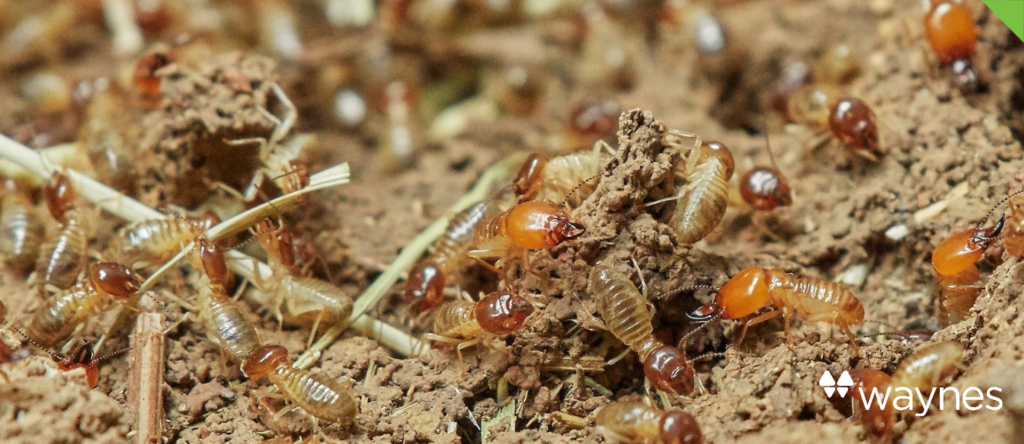Welcome to part four of a four-part series where we’ll be exploring all the various backyard bugs and the best ways to avoid the worst of their problems. For this installment, we’ll be dealing with the flying, stinging bugs — red wasps, hornets, horseflies, and yellow jackets. All have their own unique and wonderful problems, but the solutions for getting rid of them all are remarkably similar.
Types of Stinging Bugs
Red Wasps
Red wasps are not as aggressive as yellow jackets, although they look much more intimidating. Red wasps are about an inch long, with red bodies and dark, purplish-black colored wings. As they feed on nectar, they are common in backyards with lots of trees and flowers. Their nests are identifiable by their chewed wood, and the bigger the nest, the worse the infestation. They only sting when provoked or defending their nests, and only female red wasps carry venom. Males can’t sting. Their stings are painful but have few lasting effects unless a person has an allergy to the venom. If you are seeing lots of red wasps on your property, keep an eye out for nests as it’s best to remove them before they get too large. You can simply spray them down with a garden hose. The red wasps return to the nest at night, so it’s best to strike than to eliminate the entire colony at once. Wayne’s can help you target windows and door frames, inside and under eaves, around outbuildings, and under decks where red wasps are prone to build nests.
Hornets
Luckily, not all hornets are “murder” hornets, although the average species can be quite aggressive. They resemble yellow jackets but are much larger, approximately 1-1.5 inches long. Hornets start building nests in early spring. They like to build on overhanging eaves, on the branches of trees, and on outdoor siding. Be careful of food scraps from outdoor eating areas as these can be a beacon for hornet activity! They can be very aggressive when their nests are threatened and have been known to squirt venom into the eyes of their foes, causing temporary blindness, so make sure your pets aren’t nosing around any hornets! Hornet stings are similar to wasp and yellow jacket stings in that they are temporarily painful but only cause lasting effects if you have an allergy. If you are allergic to hornet venom, however, there can be a systemic shock to your whole body, not just a localized bite. Better to eliminate the hornets now rather than find out if you are allergic later!
Got a stinging pest problem? We can help you identify the issue and create a custom solution!
Horseflies
Horseflies are those huge, loud, buzzing flies that are persistent and painful to have in your backyard. Much like other backyard pests, they like heavily wooded or forested areas, and they require wet soil or a body of water for larvae to develop. Adult horse flies are very strong fliers and capable of flying up to 30 miles at a time. They typically wait near paths and roads for potential hosts to pass by, attacking dark, moving objects. While horse flies feed on nectar, not flesh, female horse flies require a blood meal in order to reproduce. The reason why their bites are so much more painful than your average mosquito is that they use their mouths for biting into the host and lapping up the blood, rather than using a proboscis to pierce the skin and suck up the blood like through a straw. Some horse flies are vectors for disease, but mostly livestock – unless you own cattle you don’t have to worry about this one. Effective horse fly repellents are candles and torches – burning citronella or other smoke-producing candles during outdoor gathering can help keep these pesky pests away.
Yellow Jackets
Yellow jackets look like hornets, but are very different in their aggressiveness and habits. They are much slower to sting, but are very territorial – if you are near a yellow jacket nest watch out! Yellow jackets are found worldwide, with 16 species living in the US. Like these other stinging bugs, yellow jackets feed on nectar. They do consume protein, but only in their larval stage. Worker yellow jackets will bring back dead insects and other meat to the nest as food for the larvae. In this way, they can be an important part of your backyard ecosystem as long as the nest isn’t near your home or outdoor activity areas. They can actually help keep other insect populations down as well as being effective pollinators for your garden. Yellow jacket bites are different from these other stinging bugs in one important way – you can become hypersensitive to yellow jacket venom after being stung. A single bite is not that bad, but beware of disturbing the nest!
What Can Waynes (and you!) Do About These Stinging Pests?
We cannot overemphasize enough that the best tool is prevention. Of course, you can’t eliminate all of the habitats of these stinging bugs as some of them like to nest on the sides of your house, but keeping an eye out for any developing infestations can help you take care of these pests before they become a problem. One important tool in your fight against these flying stingers is wasp freeze – this spray can stop these bugs in their tracks and can help kill and take down nests. As we mentioned above, too, your water hose can be very effective in knocking down the papery nests of wasps and hornets when you see them start to materialize. But always remember that these are all stinging insects – when in doubt, let Waynes help you out! Proper removal of these insect nests may require special equipment and safety precautions, and Waynes has the gear and the know-how to take care of the situation. Contact us today!









